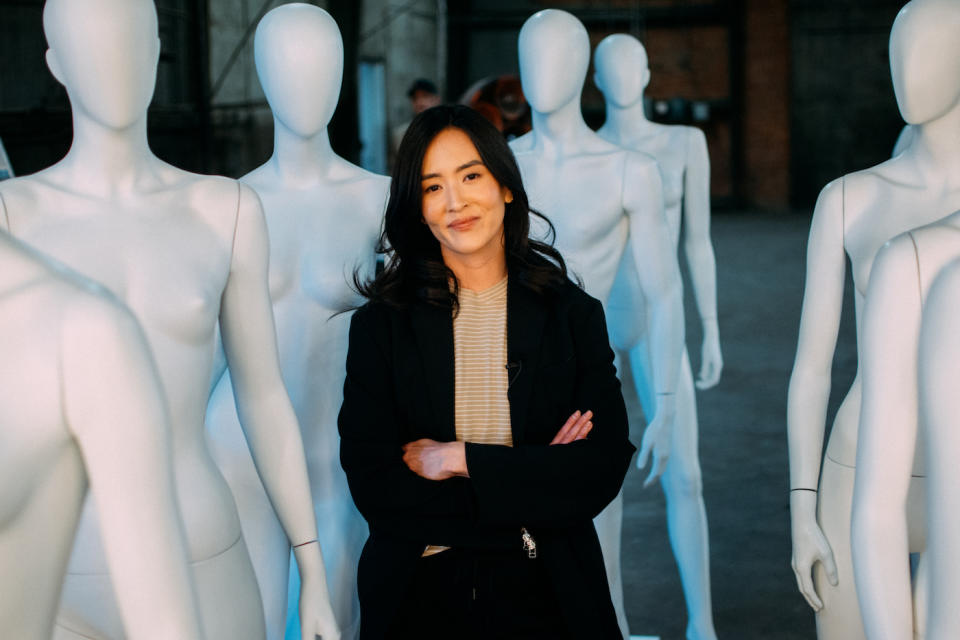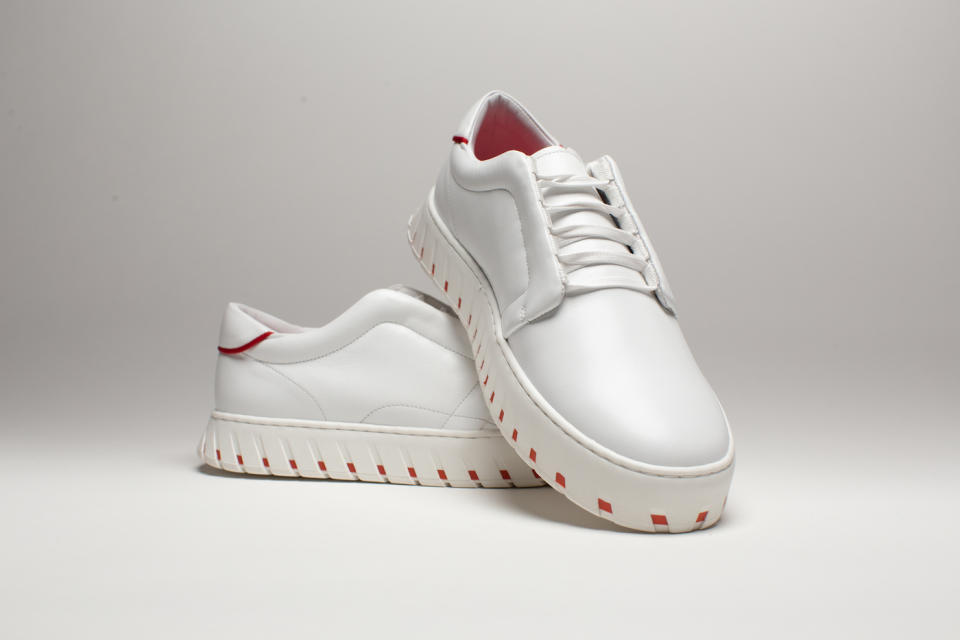This Bespoke Sneaker Startup Marries Science With Artistry

Click here to read the full article.
Iambic attributes its parade of success to the universe.
But good vibes alone didn’t give the bespoke AI-driven, precision-fit sneaker company nearly $300,000 of government funding, industry veteran backers, or a place in this year’s Harvard Alumni Entrepreneurs Accelerator cohort. Its CEO, the self-proclaimed “unlikely fashion founder,” Maeve Wang, did.
It all began when Wang realized she had returned 300 pairs of shoes in three years. Painfully aware of the environmental logistics of this fact, she grimaced in retrospect. But the at-the-time Bain & Co. associate consultant had tried every footwear fit app and every plugin available to find shoes that fit with zero success.
“I even had my boyfriend drive me to upstate Connecticut and deep New Jersey to go to the most specialty shoe stores so I could check out the fanciest foot scanners and gait analysis systems,” she said. “And it yielded nothing.”
But as Wang left Bain for Delos, a company dedicated to harnessing evidence-based solutions to enhance health and well-being, she approached her footwear issues through the lens of data matching.
“There are literally billions of shoes in the world,” she said. “It’s just a matter of being matched with the ones that fit me.”

And so she went “down the rabbit hole,” eventually applying for a grant in 2020 from the National Science Foundation (NSF) in the digital health program to develop a smartphone-based foot scanner to accurately predict shoe styles and sizes based on 3D modeling and material science.
A year into development—and the Covid pandemic—Wang and her co-founder, Raza Hassan, collaborated with brands to not only test the app but gauge its accuracy. Something a lot of those brands had never experienced before with other fit technology companies, Wang said. But she was working with hundreds of thousands of government dollars—she couldn’t afford not to know if their creation was a success.
It wasn’t.
“We were like, holy cow, is it us? Or is it the shoe?” she said. That was when they discovered between three- to 20-millimeter discrepancies between the product specifications, the design files provided and the actual physical product. “It didn’t matter what the foot measurements were because the product data was inaccurate,” she said.
While that might not sound that dramatic, considering a shoe’s half size is four millimeters, these were wrong by up to two full sizes. No one throughout the “antiquated and fragmented” supply chain took accountability,Wang said, and enacting change could take up to 10 years.
“It was really eye-opening, to say the least. Our team was like, ‘do we tactically want to spend the next 10 years trying to work with all these different pieces around the globe that need to be stitched together?’ And we’re like, ‘ah, maybe not,” she said. “That’s when we thought we had to start with the individual and do it ourselves. And we just got really, really lucky.”
Wang’s referring to the third co-founder, Tyson Park, who passed away suddenly last year. Park put the team in contact with all the right people to launch what would become Iambic. This led to a relationship with M Coleman Horn, an “industrial design legend” in Wang’s eyes, who told her that Iambic was the most ambitious project in the footwear industry he’d ever heard of. If they could achieve even a fraction of their vision, it would be worthwhile.
By 2022, the app was scrapped and the team was wholly focused on Iambic. Within that year, the company had a supply chain and factory in Portugal and over $1 million in funding from angel investors.
But remember that federal grant money? Wang had to reapply for it.
“We had to go and resubmit a whole new protocol, a whole new feasibility plan and just wait and pray that they didn’t take [the grant] back,” she said. “And we were just so lucky that our program manager used to work for a footwear supplier for Under Armour, and so he understood our problem more deeply.”
That project manager was Alastair Monk, and he awarded Iambic a Small Business Innovation Research (SBIR) Phase 1 project grant of $265,000 in September 2021. This grant backs the notion that Iambic’s analytics platform combines computer vision, material science, and computational biomechanics, merging the personal and product data needed for virtual fit simulation. Through Iambic’s API-as-a-Service, e-commerce retailers and brands can deliver smartphone-based virtual fit assessments and personalized fit analysis.
Monk isn’t the only believer, either. In March, Wang and her team at Iambic were selected to join this year’s cohort of the Harvard Alumni Entrepreneurs (HAE) Accelerator program, powered by Silicon Valley global venture capital firm Pegasus Tech Ventures. (Wang holds a Bachelor’s degree from Harvard University in government with a minor in economics.) The industry-agnostic program is a zero-equity accelerator and doesn’t offer any investment or funding and accepted 11 early-stage startups from a field of 101 applicants. Last year’s cohort featured DeltaX, a digital freight platform that connects shippers with carriers and truckers, among others.
Iambic’s got sole
“Every single detail, every stitch, every little ridge, lump, bump—they all have a function assigned to it,” Wang said, referencing the grid-like structure on the bottom sole of the sneaker. “We made [the grid] to be more like a tire tread because it’s named after Tyson; he was a big car enthusiast.”

The Model T features a red dotted line above the sole’s outer tread, which is the crux of the shoe. With wear and tear, the red layer will reveal itself and, in doing so, reveal the wearer’s walking patterns—their gait, stride, balance. Once the shoe becomes so worn down it’s no longer desirable for us, customers can ship their sneakers back to have the data analyzed and applied to their next pair of custom kicks. If they can’t mail the shoes back, they can take photos at different angles that Iambic will then apply image processing to in order to harvest the data. But it’ll take some heavy wear for that red layer to expose itself, Wang said, as she believes it’s one of the sturdiest sneakers around.
“All of that information is always lost once you are done with your shoes; the brands, the manufacturers, they never see it,” Wang said. “They never see the actual physical data that this collects on you or their product. And we were like, ”OK, this is an opportunity for us to do that.’”
But all that information complements the data captured via foot scanning technology that goes into creating the shoe’s last, the starting point of every shoe design. But Iambic didn’t initially want to create its own sole; there are so many soles on the market already, it just needed to find the right one to adapt to each last. That proved to be so difficult, however, that the team decided to make their own.
Utilizing 30 adjustable points, Iambic’s algorithm can pull in or pull out those points based on the foot measurements to preserve certain design ratios but still achieve a sneaker that fits uniquely to the wearer’s foot.
“What’s fascinating is that back in the day [2021] when we talked about using AI to do that, because of the complexity of this, people were like, ‘don’t talk about AI,’ like, no one cares about AI when you talk about your sneaker,” Wang said. “Just talk about the feel and the comfort, and we were like, OK. Now, it’s like, ‘Why don’t you start every conversation with AI?’”
Bespoke shoes with this level of customization typically cost between $3,000 and $10,000 and can take up to a year to make, Wang said. It’s still a fully handmade process; even a few degrees off could result in a last that looks like “a clown shoe,” which is why the process is so expensive and drawn out. Iambic wants to address both of those problems to bring the beauty of bespoke to the masses.
The company’s white-glove service, dubbed “the executive experience,” debuts in New York City next month. The not-for-scale service is only available to the first 600 endorsers of the sneaker. Those early adopters will receive NASA-approved foot scanning technology to the tune of $1,100 for the pilot sneakers, which will take four to eight weeks to make.
“We see [the price] as one-tenth of the highest end that you can get for traditional bespoke,” Wang said. “It’s like if we can double the benefits at one-tenth of the price, that’s revolutionary. You can’t get a shoe that actually, like, is effectively this big fuzzy wearable that self improves. That’s how we see it.”
Following the pilot launch, Iambic will be opening the waitlist and rolling out the for-scale version of the Model T, which utilizes the smartphone-based scanner alongside the 10 comfort questions and will take about six weeks to make. The ultimate goal is to release a third model by 2028 with an accessible price point of $200 and six weeks to make as well.
“We’re just a bunch of nerds who wanted to get it right,” Wang said.

